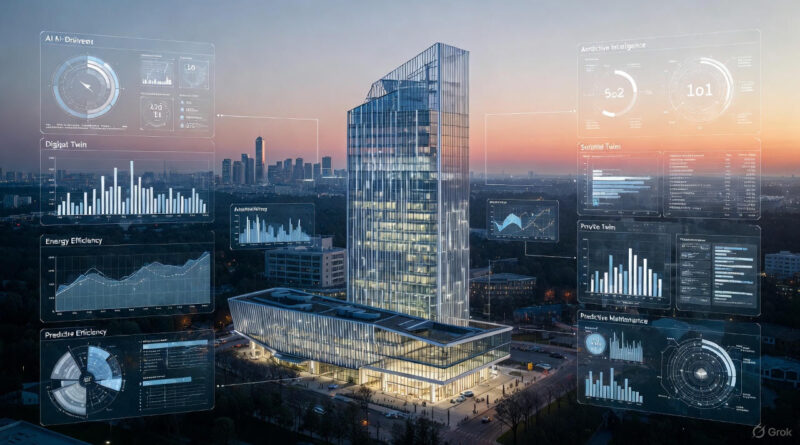AI-Powered Predictive Maintenance and Self-Learning Buildings: The Dawn of Truly Intelligent Structures
Imagine a building that anticipates your needs before you even realize them. A skyscraper that detects a failing chiller pump weeks in advance, schedules repairs during off-hours, and dynamically adjusts airflow based on real-time occupant patterns. This is no longer futuristic—it’s the present reality in forward-thinking commercial buildings, driven by AI-powered predictive maintenance and self-learning building automation systems (BAS).
As of 2025, the building automation industry is transforming rapidly. The global BAS market is projected to reach $191 billion by 2030, fueled by IoT integration, energy efficiency demands, and AI advancements (MarketsandMarkets Building Automation System Market Report).
Traditional systems are evolving into intelligent platforms that cut maintenance costs by 20–40%, deliver 15–35% energy savings, and adapt autonomously to create more sustainable, occupant-friendly spaces.
From Reactive to Proactive: The Power of Predictive Maintenance
Building maintenance has long relied on reactive fixes or rigid schedules—both costly and inefficient. Unplanned downtime disrupts operations, while over-maintenance wastes resources.
AI-powered predictive maintenance (PdM) changes this by leveraging machine learning, such as Long Short-Term Memory (LSTM) networks, to analyze IoT sensor data in real time. These systems detect anomalies—like vibration spikes or irregular energy patterns—and predict failures with high accuracy.
Proven impacts include:
- Johnson Controls OpenBlue platform — Delivers up to 30% energy savings in HVAC and lighting through predictive analytics and AI-driven optimizations (Johnson Controls OpenBlue).
- A 40-story Tokyo office tower — Used AI to detect fan vibrations and compressor issues weeks early, avoiding $40,000 in emergency repairs and downtime (Analytika by Aktila case study).
- A Riyadh commercial building study — Applied LSTM-based PdM to HVAC components, enabling precise remaining useful life forecasts and reducing unplanned outages (MDPI research paper).
- BrainBox AI deployments (now part of Trane Technologies) — Achieve 15–25% HVAC energy reductions and up to 40% lower emissions by predicting and optimizing performance autonomously (BrainBox AI official site & Trane acquisition announcement).
Leading vendors like Honeywell, Siemens, Schneider Electric, and BrainBox AI integrate PdM seamlessly with existing BAS. The ROI is clear: investments often pay back in 12–24 months through fewer repairs, lower energy use, and extended equipment life (industry benchmarks from Deloitte and vendor reports).
Self-Learning Buildings: The Next Evolution
Beyond prediction, self-learning buildings use reinforcement learning and deep neural networks to adapt without manual intervention. They learn from occupancy trends, weather, and grid signals to optimize HVAC, lighting, and more.
Key features:
- Edge AI and digital twins for fast, local decisions and scenario testing.
- Occupancy analytics that create personalized comfort zones—especially valuable in hybrid work environments.
- Renewables integration to balance solar, storage, and demand response dynamically.
Notable examples include BrainBox AI turning HVAC systems into “thermal batteries” for grid flexibility and KODE Labs’ Smart Building OS unifying disparate systems for 30%+ energy and carbon reductions (KODE Labs platform overview).
Hype vs. Reality: Overcoming Challenges
Challenges remain: many legacy buildings lack sufficient sensors, cybersecurity risks increase with connectivity, and “black box” AI can reduce trust. Privacy concerns around occupant data and upfront costs are also common.
Solutions are advancing quickly—zero-trust security architectures from Siemens and Honeywell, improving explainable AI, and subscription-based models that eliminate large CapEx barriers (Siemens Building X cybersecurity features; Honeywell Forge Cybersecurity).
The Bottom Line: A Massive Opportunity
By 2030, AI-optimized buildings could save billions in energy and dramatically cut emissions, perfectly aligning with tightening regulations like the EU Energy Performance of Buildings Directive (EPBD) and U.S. standards.
For owners and operators: Start with an HVAC PdM pilot (HVAC typically accounts for 40–50% of building energy). Assess your data readiness, choose interoperable platforms, and scale strategically.
Self-healing buildings are here today. In 2025, the most advanced structures don’t just respond—they predict, learn, and sustain our world one intelligent decision at a time.
Ready to assess your building’s AI potential? The path to efficiency and savings begins now.

Pingback: The Explosion of Digital Twins in Building Automation: Why 2025 Is the Tipping Point - System Control Tech